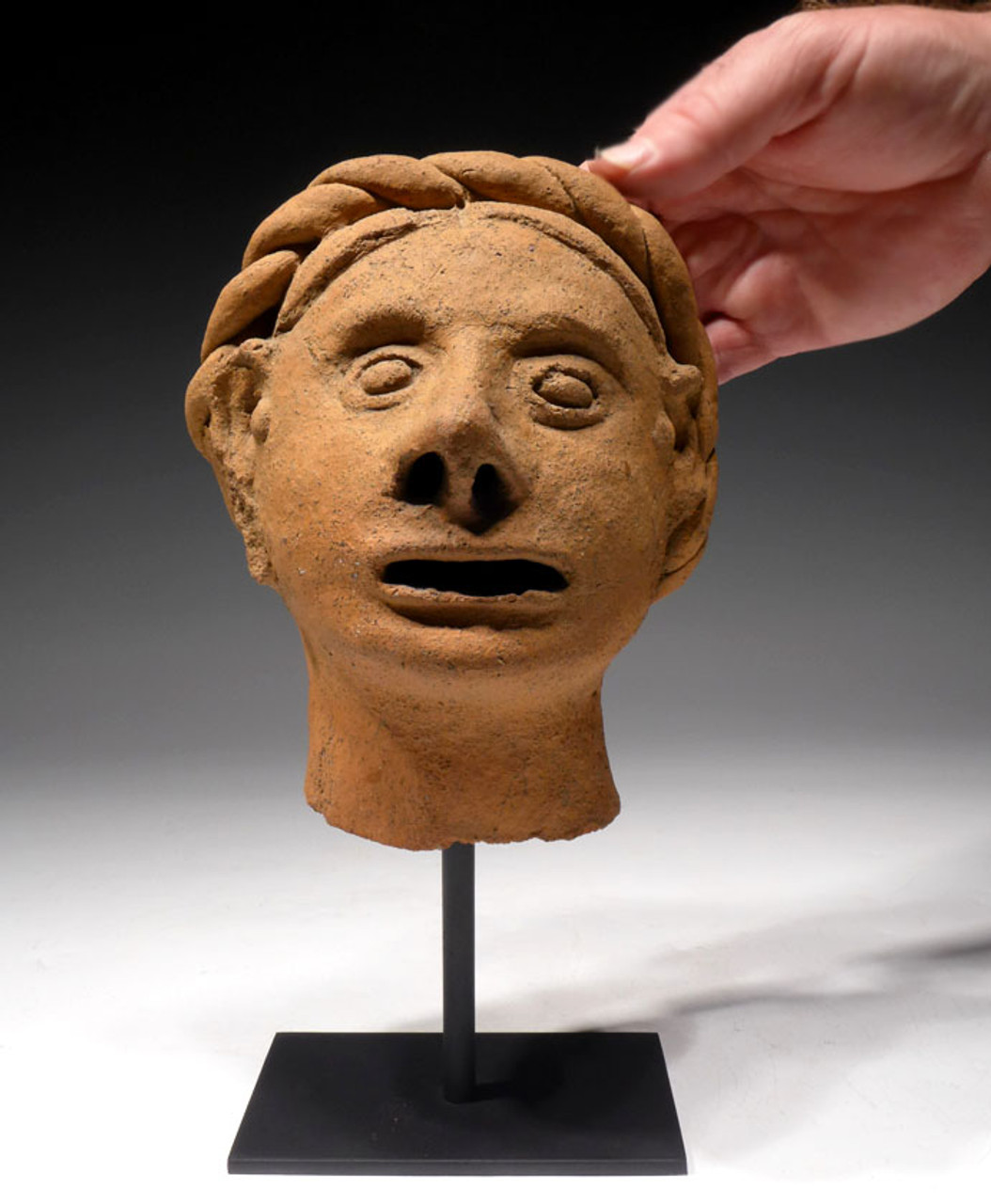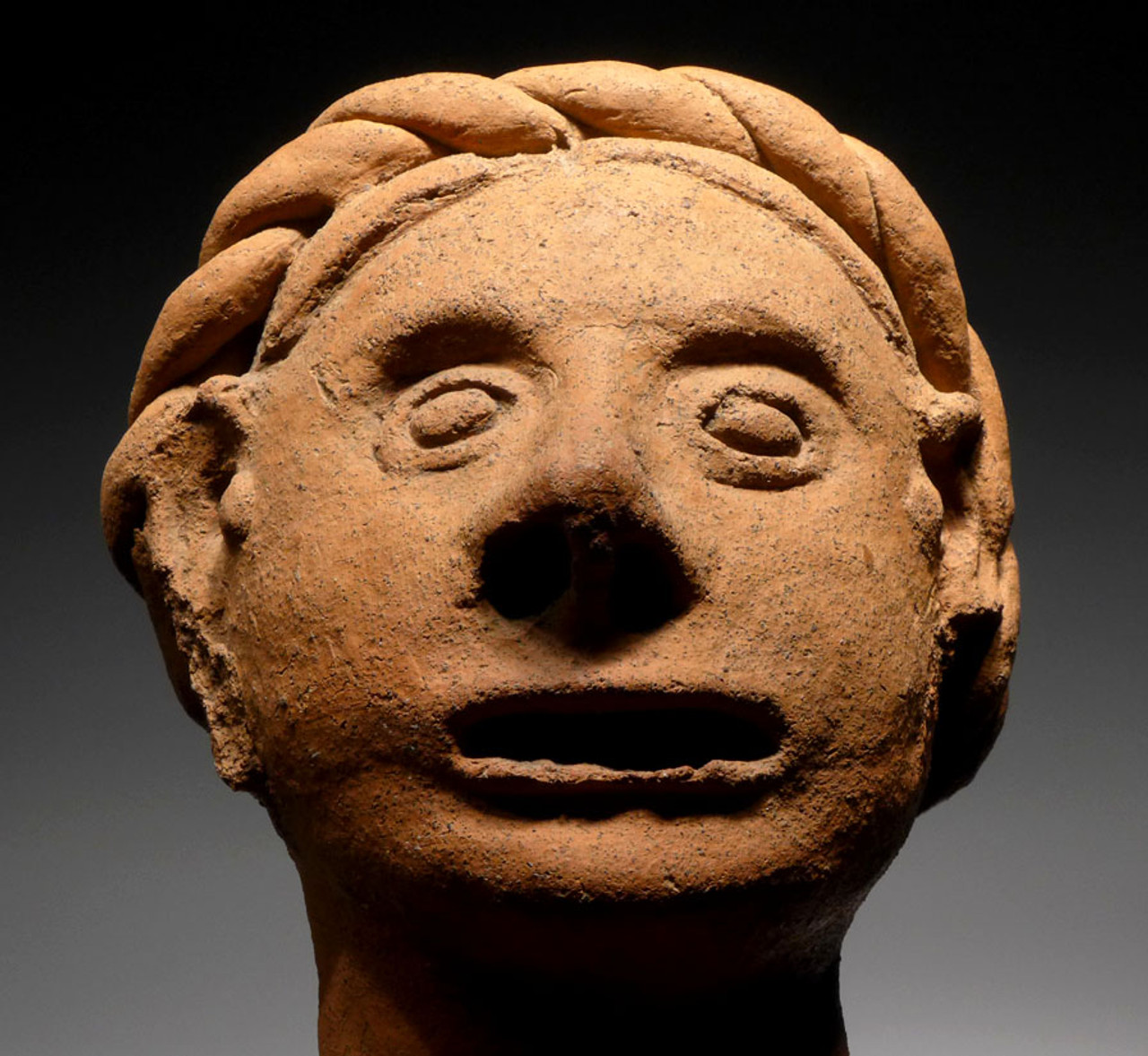Product Description
Pre-Columbian antiquities from pre-Spanish contact are widely varied and well-known. The existence of most tribes spanned hundreds to thousands of years prior to European explorers arriving. What is rare are those artifacts that show evidence of the EARLIEST of Spanish contact when the indigenous people converted to Christianity voluntarily, or by force. The Spanish conquering of the Aztecs was especially thorough. The abhorrence of the Aztec rituals and their perverse love of violence and gore is well-documented by the Spanish who were shocked by the Aztecs' obsession with the macabre and their brutal festivals of human sacrifice and cannibalism. The Spanish made especially sure that everything of this society was destroyed as much as they could. This is the reason that artifacts attributed to the Aztec culture are especially scarce today. After their submission to the conquest, the Aztecs (and many other indigenous tribes of the land) adopted Catholicism as their new religion and former worship of a Mother Goddess evolved into veneration for the Catholic Virgin Mary. All other deities were considered paganism by their conquerors. Objects from this very early Christianization of Mesoamerica are RARE and extremely insightful as to this early period of "thought re-alignment". This ceramic bust is one of the most impressive examples of that event.
This is a "Christianized" bust of TONANTZIN, the term for "mother goddess" of the Aztec Pre-Columbian Indians. Tonantzin is often shown wearing large ear spools and the original Pre-Spanish contact Aztec deity that this head was once of, once possessed such ear spools. Instead of sharing the fate of so many other Aztec objects and being destroyed, the bust shows obvious removal of the ear spools, most likely in the effort to continue in life as a Christian bust of the Catholic Virgin Mary that was a centric theme to the Spanish conquerors. The rarity of this example cannot be over-stated. While later colonial objects of post-Spanish contact can be found, those ceremonial objects that existed BEFORE the arrival of the Spaniards, and were later converted to acceptable standards after, are ULTRA-RARE and important evidence of Mesoamerica's cultural conversion.
Bust shows typical headdress for Tonantzin, as well as very late Aztec artistic style in the sculpture features. A true MUSEUM-CLASS example of early Spanish contact with the Aztecs. From the former collection of a U.S. government operative who worked in Central and South America during the 1950's and 1960's and imported into the U.S. by him, during this tenure.
Mineral and sediment deposits are evident and provide irrefutable indicators of authenticity and age, ONLY found in ORIGINAL specimens such as this.
HISTORY
While many ancient civilizations remain a mystery, little can be left to conjecture when it comes to the details of the Aztec way of life. An extensive and detailed collection of written and pictorial records exist for us today called CODICES (CODEX if singular) were produced before Spanish contact by the native tribes themselves, and afterwards during the Colonial period. These codices were created by the Aztecs in pictorial form, as well as by other indigenous tribal sources, all of which had no written language. Colonial era codices exist in greater number with roughly 500 separate codices known, showing extensive pictograms as well as being written in Spanish, Latin and in the original Nahuatl language.
The origin of the Aztec (Azteca) Empire is legendary. Aztec codices record that they began their wandering journey in 1100 A.D. emerging from their former homeland called Aztlan or "place of the herons", an island in a lake where men went out to fish from boats. The exact location of this region is not known but other than it was northwest of present-day Mexico City, the former center of the Aztec empire, but how far, it is a mystery.
The Aztecas believed they were guided by a blood-thirsty deity they called Huitzilopochtli who communicated to them through four priest-chieftains called teomama. Their god called upon them for his insatiable thirst for human blood and sacrifice. As they migrated south, every indigenous Indian tribe they encountered along the way abhorred the Azteca, as they were known, as they were reviled and scorned for their violent and barbaric ways. During their migration, Huitzilopochtli gave a message to his people that their new identity would no longer be known as Azteca but as Mexica. In around 1325 A.D., as they were fleeing an altercation with the Culhuacans, they were driven to a marsh. Their god Huitzilopochtli consoled them that evening and said he would end their wandering and told them to look for a sign that he will give them that will signify their new homeland which will be "the place of the cactus and the eagle I now name Tenochtitlan". They next day they witnessed an eagle resting on a prickly pear cactus which they interpreted to be the sign they were hoping for.
This marsh, Lake Texcoco, would later become a vast canal-laced highly advanced, super city of stone pyramids and temples known as Tenochtitlan. With a population that grew to an estimated 200,000 people (three times the largest city of Spain at the time!) this became the center of the most powerful and militaristic empire of Mesoamerica - home of the Aztecs. Today, we classify their reign as occupying the Late Post Classic Period from 1250 - 1521 A.D.
The success and rise of the Aztec empire was largely attributed to their dominance through intimidation of their surrounding neighbors from whom they extracted resources from. The effect of their extreme militarism and brutality on their enemies brought a large region of peoples into submission. The highly advanced and complex Aztec social structure, as well as legal system, kept their growth intact and the society orderly. They formed an alliance with the Texcoco and Tlacopan tribes and in 1428 A.D., they defeated the Tepaneca. This triple alliance established a great empire that was predominantly ruled from Tenochtitlan. At its peak, this empire included a large, diverse group of people and spanned an area from the entire Central Mexico region south, into northern Guatemala.
 US DOLLAR
US DOLLAR
 EURO
EURO
 AUSTRALIAN DOLLAR
AUSTRALIAN DOLLAR
 CANADIAN DOLLAR
CANADIAN DOLLAR
 POUND STERLING
POUND STERLING




















